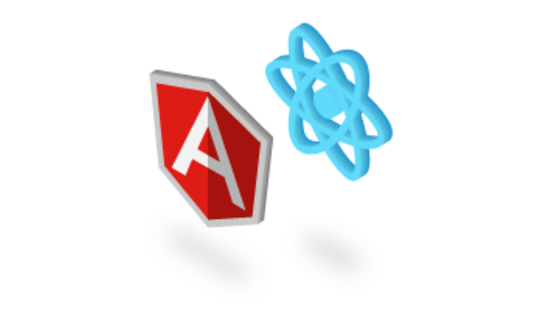-
Product Management
Software Testing
Technology Consulting
-
Multi-Vendor Marketplace
Online StoreCreate an online store with unique design and features at minimal cost using our MarketAge solutionCustom MarketplaceGet a unique, scalable, and cost-effective online marketplace with minimum time to marketTelemedicine SoftwareGet a cost-efficient, HIPAA-compliant telemedicine solution tailored to your facility's requirementsChat AppGet a customizable chat solution to connect users across multiple apps and platformsCustom Booking SystemImprove your business operations and expand to new markets with our appointment booking solutionVideo ConferencingAdjust our video conferencing solution for your business needsFor EnterpriseScale, automate, and improve business processes in your enterprise with our custom software solutionsFor StartupsTurn your startup ideas into viable, value-driven, and commercially successful software solutions -
-
- Case Studies
- Blog
How to Choose Between Angular and React for Your Next Project
Angular and React are the avant-garde of the front-end world. These JavaScript-based technologies, although very different, are both used for developing single-page applications (SPA). And to stay at the cutting edge, both of these technologies are constantly updated. But if Angular and React are both innovative, well-supported tools that are useful for building front-end applications, then what actually sets them apart? More importantly, which is better for building your single-page application? And what kinds of applications can we build in React and Angular? React vs Angular: what fits you best? These are the questions we’ll be addressing today.
Let's assume you’re looking to build a simple To-Do List app. You’ll let users add tasks to lists and save lists; edit or delete those tasks, or mark them as done; and sort within lists based on active or completed statuses. The To-Do List app we’ve just described is very small. This application also updates only one part of the view (HTML). That is, you can enter and save a single task at a time. Just take a glance at TodoMVC – which uses Angular JS – for an example of what this might look like.
Is it possible to create this very same application in ReactJS? It’s indeed possible. Check out the ReactJS variant of TodoMVC to see for yourself. But now the question arises as to which technology is better for making front-end apps, considering that both AngularJS and ReactJS suffice for single-page applications.
Before we address this perplexing choice, let's first identify the main aspects of Angular and React that we must consider:
- Performance;
- Suitability for projects of various sizes;
- Search engine optimization (SEO);
- Development speed.
In the sections below we will look at these aspects individually.
AngularJS performance vs ReactJS performance
The performance of a front-end application depends mostly on how HTML is updated. In other words, the more efficiently a JavaScript framework or library modifies the Document Object Model (DOM), the better the experience will be for the end user. In terms of updating HTML, React and Angular take two completely different approaches.
AngularJS 1.x (before Angular 2) makes changes directly in the DOM in the browser. But this may not be convenient for users with older computers or slow mobile devices, since updating the DOM directly can eat up a lot of CPU cycles and slow down applications. An AngularJS application may also get sluggish if we use too many bindings between the parts of the application, which can also cause it to use too much memory on a client's device.

The ReactJS library boasts of implementing a very efficient approach to updating the DOM. The virtual DOM is a concept designed to increase app performance. The ReactJS creators at Facebook adapted the single-page application architecture to produce a low load on any device. They accomplished this by moving calculations from the client to the server. This is a serious shift from the old-fashioned thin server architecture when the client (the browser in the user’s device) was in charge of all computations. A thin server architecture is used in most front-end Model-View-Controller (MVC) frameworks, but was abandoned by React.
To improve the performance of the AngularJS framework, the developers of Angular copied this ReactJS philosophy and introduced a virtual DOM in Angular 2, acknowledging the power of the virtual DOM for single page applications.
Based on what we’ve said about the DOM, we can deduce that AngularJS 1.x is best suited for single-page applications that update their content only occasionally, while ReactJS and AngularJS 2 make it possible to change content continually in an app of any size.
Angular or React for Large and Small Applications
Roughly speaking, the size of an application corresponds to the number of functions it provides. But technically a small, medium, or large single-page application can be built with either Angular or React. So how can you decide which technology to use? The answer is very simple: if you want a Minimum Viable Product with only basic features, then AngularJS 1.x will suit much better than ReactJS. This is because AngularJS is a framework that contains all necessary parts of the MVC stack to help developers produce a fully working SPA right away.
But what happens when we continue adding new functionality to our AngularJS application? AngularJS will constrain our efforts because of its rigid architecture. Developers will have to work around technical limitations of Angular at a much earlier stage than they would with with ReactJS.
ReactJS is great for creating simple single-page applications, but is a practical choice only if those apps will grow larger in the future. The flexible architecture of ReactJS allows more changes during web app development. The main issue with ReactJS is that it offers little functionality out of the box, which increases time spent on the pre-development stage. Therefore, if your final application will be relatively small, it probably makes more sense to develop it in Angular, as the extra development effort required with ReactJS will be of no benefit.
Now we’ll take a closer look at the development speed with Angular and React.
Speed of Development with Angular and React
The speed at which you can develop an SPA in Angular or React depends on the number of libraries with ready functionality that are available for your developers. Having necessary libraries on-hand lets us develop an application faster. In this regard, ReactJS has several shortcomings.
As we’ve suggested, ReactJS is suitable for developing small applications that will be extended with more functionality. React's architecture is easier to scale than the classical MVC architecture in AngularJS. But this flexibility comes at a cost: developers must think hard about which instruments are best for a certain project. Given that React's community – and the number of tools – are growing rapidly, choosing the right tool for a project can take some time.

Let's consider several concrete examples of this disadvantage. ReactJS is always coupled with Flux library to create an app’s structure. And since the developer of ReactJS only suggests an approach to app architecture, there are now countless Flux implementations: Redux, Fluxx, Reflux, Fluxible, Fluxy, etc. It’s rarely evident straightaway which of these is best for a given task. Here’s another example: developers have to choose among multiple build tools, including Webpack, Browserify, and RequireJS. Oh – and we also need a JavaScript preprocessor. We could go with TypeScript, LiveScript, CoffeeScript, or Babel. And do we need to test our app? Surely, that’s important as well! So let’s choose among Karma, Jasmine, Mocha, Chai, Ava, and Tape.
This list of ReactJS libraries is hardly comprehensive. Having choices is generally a good thing, but at the first stage of app development it may be a bit difficult to figure out the best options. With AngularJS, everything is much simpler: we just add a library to our dependencies and start working instantly. In addition, AngularJS offers some valuable features in the standard package. For example, it's preconfigured with Karma for testing purposes.
In short, starting to develop an app in Angular is definitely faster than in React. However, we should add that AngularJS also requires some libraries to address certain issues such as Search Engine Optimization (SEO).
Search Engine Optimization with Angular and React
Search Engine Optimization is very important, as our application must be easy to find on the internet. In terms of Angular and React, when we consider SEO we must look back to the fundamental differences in how these technologies are built: ReactJS implements server-side rendering, while AngularJS 1.x is almost fully rendered directly in the browser.
It's much easier to set up server-side rendering with React than with Angular – and server-side rendering is better for SEO. Therefore, Angular requires additional tools to implement SEO best practices. PhantomJS is a well-known library to address SEO issues in AngularJS; it helps us set up an application so it gives a search engine prerendered HTML in-full, while the user receives usual output from the application. But this demands additional coding: web developers must create an additional AngularJS module for SEO and set up PhantomJS to present an HTML snapshot to the search engine. Many other tools similar to PhantomJS take the same approach.
To put it simply, both the ReactJS library and the AngularJS framework allow us to make a single page application SEO-friendly, but AngularJS demands more effort to achieve that goal. Additionally, it’s sometimes difficult to make an AngularJS app 100% SEO-friendly even when we do use PhantomJS or a similar tool. Admittedly, the SEO situation with Angular should become much better when Angular 2 is officially released. This latest edition of the AngularJS framework takes after React, offering server-side rendering to better overcome SEO issues related to SPA development.
Conclusions of our React vs Angular comparison
Choose ReactJS for your project if:
- You will greatly extend the functionality of your application in the future;
- You need an application that will update the view(s) simultaneously and constantly;
- You’re okay with a somewhat slower initial stage of development.
Examples of ReactJS applications: AdaptiveCluster, Mortgage Overpayment Calculator.
Choose AngularJS for your project if:
- You need a Minimum Viable Product;
- You need an application that updates only several parts of one view at a time;
- You want to start development of an application immediately.
Examples of AngularJS applications: JamStreams.net, WhichAirline.
Note: given that Angular 2 is not yet officially available (Release Candidate 5 went public on August 9, 2016), we chose AngularJS 1.x for the purpose of our Angular—React comparison in this article.















